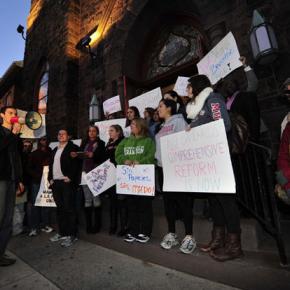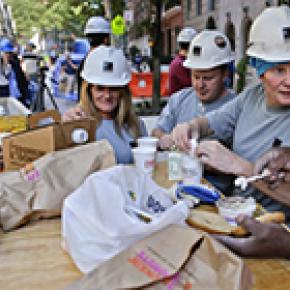Minimum wage going up
Voters have decided it’s time to give Colorado’s minimum-wage workers a long-overdue raise.
Amendment 70, a measure that would increase Colorado’s minimum wage to $12 an hour by 2020, was...
Voters have decided it’s time to give Colorado’s minimum-wage workers a long-overdue raise.
Amendment 70, a measure that would increase Colorado’s minimum wage to $12 an hour by 2020, was passing by a 10-percent margin. Minimum wage in the state is now $8.31 an hour.
With 25 of 64 counties reporting, the vote-count as of this posting was 55 percent yes to 45 percent no.
In a crowded, jubilant second-floor conference room at the Westin Downtown, a group of minimum wage earners, business owners and advocates celebrated.
“Amendment is going to help our local economy,” said Edwin Zoe, proprietor of restaurant Zoe Ma Ma. “When low income workers do well, we all do well.”
The amendment alters the state constitution to increase the minimum wage by yearly 90-cent increments until it reaches $12 in 2020. In 2020, it will be fixed at $12, except for yearly adjustments to account for inflation.
Who pushed it over the finish line?
Supporters of the increase coalesced in mid-2016 into a group called Colorado Families for a Fair Wage, a coalition of unions, economic justice advocates and progressive policy analysts. Many of them had been part of an informal consortium of anti-poverty groups called The Everyone Economy that came together to strategize about raising the minimum wage back in February 2014. Partnering with Democratic legislators, they advocated for a pair of bills in the 2015 legislative session to help low-wage workers. One would have allowed municipalities to set their own minimums, and the other would have created a ballot measure to reach a $12.50 per hour minimum by 2020. Republicans killed both bills in the Senate.
Democrats floated another bill in 2016 to allow cities to set their own minimum wages, which met the same fate as its predecessors. After that, Everyone Economy members decided they had no recourse but to pursue a ballot measure themselves and formed Colorado Families for a Fair Wage.
What does it mean that it passed?
The work is just beginning for Colorado labor unions and low-wage worker advocates. Most CFFW members acknowledge that $12 per hour is not in fact a living wage for workers with families in some parts of Colorado. Most estimates put a living wage for a single parent of two children in Denver at around $30 per hour. But advocates also believe that the current $8.31 per hour is inexcusable, and any more than $12 was not politically viable this time around.
But for some, the increase means a change in their lives. April Medina currently makes $11 per hour in assisted living. She works 60-70 hours per week, leaving very little time to spend with her four children. She brought her 9-year-old daughter, Jasmine, to the Westin Downtown to celebrate Amendment 70’s passage.
Medina said she was thrilled by the news.
“I’m excited to go to some basketball games,” Medina said.
How much firepower was against it?
Keep Colorado Working had a slower start raising funds, but raised $1.7 million in the last reporting period. It has spent just under $1.4 million as of the most recent campaign finance filings, primarily on television advertising and consultants. About half of its funds ($650,000) come from the Alexandria, Virginia-based Workforce Fairness Institute. It has also gotten $525,000 from Colorado Citizens Protecting Our Constitution, a committee that has donated hefty sums to pro-fracking campaigns and to a 2013 effort to recall legislators who had passed gun-control legislation.
CCFW outraised its rivals almost 3 to 1, raising about $5.3 million in donations, much of it from out-of-state groups like its largest donor, the Center for Popular Democracy, which has kicked in over $1 million. Its second-largest donor is the Palo Alto-based Fairness Project, which has contributed over $960,000 to CFFW and is also supporting minimum wage ballot measures in Maine, Arizona and Washington, D.C.
Keep Colorado Working wants to make sure you know that some of CFFW’s donors are not from Colorado. Virtually all of its communications use the terms “wealthy out of state special interests” liberally.
According to the most recent campaign finance filings, CFFW has spent $4.6 million on television and digital advertising, outreach efforts like canvassing and hosting events, mailers, polling and research.
By Eliza Carter
Source
Allentown protesters take to streets to urge immigration reform
The Express-Times – October 21, 2013, by Colin McEvoy -
Hilda Gonzalez, who moved from Mexico to Allentown 12 years ago, was handed a speakerphone tonight and asked to tell an assembled...
The Express-Times – October 21, 2013, by Colin McEvoy -
Hilda Gonzalez, who moved from Mexico to Allentown 12 years ago, was handed a speakerphone tonight and asked to tell an assembled crowd of 50 people her personal story.
But when the time came, Gonzalez said she couldn’t bring herself to do it because her own experiences felt so small compared to the roughly 11 million undocumented immigrants living in America.
“These are immigrants who have experienced the fear of being separated from their families,” she said. “Immigrants who have many times had to duck their heads. Immigrants who aren’t treated with dignity.”
Gonzalez was one of about 50 people who took to the streets of Allentown tonight in protest, urging their legislators to take action on immigration reform now that the government shutdown has been resolved.
“I think it’s well overdue that we as a nation do the right thing,” said Guillermo Lopez Jr., of Bethlehem, as the group marched on Hamilton Street. “No human is illegal. That is the truth of this land.”
With the debt ceiling crisis temporarily averted, President Barack Obama has urged Congress to pass a comprehensive immigration reform bill by year’s end.
The Senate approved such a bill in June that included investments in border security and a path to citizenship for millions of undocumented immigrants. But the House did not take action on such a bill and many in Congress have expressed skepticism that action will be taken now.
The Allentown protesters held such signs that read “We yearn to breathe free” and “We bleed red, white and blue,” and chanted phrases such as “Undocumented, unafraid” and “No papers, no fear.”
They carried candles and flashlights, which symbolized the hope that reform could bring immigrants out from the darkness, according to organizer Max Cohen, of the Center for Popular Democracy, which organized the event in conjunction with Communidad Unida de Lehigh Valley.
A similar rally will be held Tuesday in Easton, urging support for a resolution Easton City Council is scheduled to consider urging Congress to enact immigration reform.
That rally, run by Organizing for Action, will be held 5 p.m. in Centre Square, with the city council meeting starting at 6 p.m.
The Allentown protesters voiced particular hope that U.S. Rep. Charlie Dent, who they called a “level-headed, moderate Republican voice in Congress,” would be an outspoken voice on the issue.
Dent previously said the Senate’s bill had major problems, saying the border security elements in particular needed strengthening.
“We will work on practical solutions that respect the rule of law while responsibly dealing with the 11 million people, slightly less than the population of the Commonwealth of Pennsylvania, who are in this country unlawfully,” Dent said in July.
But the protesters said they hope Congress will move quickly before the midterm elections become too much of a distraction.
Among the participants was Adrian Shanker, president of Equality Pennsylvania, who said there are about 1 million gay, bisexual or transgender immigrants in the United States, and about one-third are undocumented.
“We can’t be equal until we are all equal,” Shanker said. “Eleven million people live in the shadows. That is not freedom.”
Source
Progressive Groups Press Hillary Clinton On Wall Street's Golden Parachutes
The groups note that during Clinton's tenure as secretary of state, two of her aides -- ...
The groups note that during Clinton's tenure as secretary of state, two of her aides -- former Deputy Secretary Tom Nides and former undersecretary Robert Hormats -- received large bonuses, or "golden parachutes," from their Wall Street employers when they left to join Clinton's staff. Nides worked at Morgan Stanley before he joined the State Department, and has since returned; Hormats worked at Goldman Sachs.
The letter asks whether Clinton still supports this type of bonus and whether she would allow new employees in her administration to receive the same kind of compensation, should she become president.
"Awarding outsized bonuses and gifts of equity to Wall Street executives who temporarily leave to go into public service is either a breach of a public corporation’s fiduciary duty to its stockholders, or a down payment on future services rendered," the letter said.
"If the latter, it at best creates the appearance of corruption and conflict of interest. At worst, it results in undue and inappropriate corporate influence at the highest levels of government -- in essence, a barely legal, backdoor form of bribery."
Sen. Tammy Baldwin (D-Wis.) and Rep. Elijah Cummings (D-Md.) recently proposed legislation that would ban golden parachutes and reduce the number of government officials who have past ties to the industries they are supposed to regulate. Two of Clinton's primary opponents -- Sen. Bernie Sanders (I-Vt.) and former Maryland Gov. Martin O'Malley (D) -- have backed the legislation, the letter to Clinton noted.
"Golden parachutes for government service are rare in most industries, but common among senior government officials who were previously employed at Wall Street banks," the letter continued. "Golden parachutes have become so common and corrosive to the public trust that it has become clear the next president should prohibit executive branch employees from receiving them altogether."
Clinton's campaign did not return a request for comment about whether she would support Baldwin and Cummings' bill, and has previously declined to comment about golden parachutes for stories from other media outlets.
Sen. Elizabeth Warren (D-Mass.), a major champion of dismantling the link between Wall Street and the federal government, called Baldwin and Cummings' legislation “a bill any presidential candidate should be able to cheer for” in July, and encouraged progressives to press presidential candidates on the issue.
The groups who sent the letter to Clinton are Rootstrikers, American Family Voices, Center for Popular Democracy Action, CREDO Action, Democracy for America, Friends of the Earth Action, MoveOn.org Political Action and The Other 98%. The organizations said in a press release that they collectively represent more than 9 million Americans.
Source: Huffington Post
How Did New York Become the Most Unionized State in the Country?
The Nation - September 3, 2014, by Michelle Chen - With all the filthy lucre sloshing around on Wall Street, New York City may not strike you as a bastion of organized...
The Nation - September 3, 2014, by Michelle Chen - With all the filthy lucre sloshing around on Wall Street, New York City may not strike you as a bastion of organized labor. But the city is in fact the nation’s leading union town. And in the past year, according to researchers at the City University of New York, there has even been a slight increase in unionization in the five boroughs.
About 24 percent of wage and salary workers in New York City are union members, a small but significant increase over the past year, from about 21.5 percent in 2012 . Statewide, according to Current Population Survey data analyzed in the study, New York remains the most union dense state in the country at 24.6 percent of workers.
According to the authors, Ruth Milkman and Stephanie Luce, the increase—amid a multi-year trend of decline—appears to be driven by hiring trends, not organizing new sectors. As the so-called “recovery” boosts labor demand, long unionized industries are just hiring more. “There are some new organizing efforts here and there, but nothing that accounts for this [increase],” Milkman tells The Nation. “It seems to just be shifts in the labor market reflecting long-unionized sectors that are rebounding.”
Union density in a large population offers only a rough gauge of actual labor activity. The overall number of union members may fluctuate from year to year whenever big unionized industries add or shed jobs, Milkman explains, but that does not capture, and could even mask, the effect of new union formation in smaller-scale workplaces—like the handful of immigrant workers who have recently unionized at local carwashes.
Much of last year’s growth in union workers has come in the construction industry, where unionization in the NYC metro area is about 27 percent, and 30 percent statewide—about twice the industry rate nationwide. But construction trades are a mixed bag, because employers can use both union and non-union workers on different jobs, and the industry runs on short-term contract work. Milkman says the recent trendlines point to growth in both union and non-union construction jobs, but with relatively strong growth among union members.
Overall, New York’s unionization rates are highest in the public sector, at about 70 percent. But surprisingly, recent expansion of union membership centers on private-sector workplaces. Alongside union boosts in the building trades, unions have made gains in building-based services, like janitors and porters, and hotels, where over a third of the labor force is union.
Though undocumented immigrants often work non-union jobs, immigrants (who make up about 37 percent of the city’s population) are rapidly joining the union ranks. Though newer immigrants have relatively low rates of unionization, according to the report, among immigrants who arrived before 1980, the rate is actually higher than that for US-born workers in both New York City and statewide. Black unionization rates have been the highest of any racial or ethnic group, Asians the lowest.
Though union workplaces generally offer higher wages and better benefits, union jobs face multiple threats from displacement and eroding working conditions. Building trades employers, for example, have recently shifted away from a longstanding agreement to stick to using union labor, enabling large developers to hire cheaper non-union and “off the books” workers, including many undocumented immigrants. A “two tier” labor structure, in which union and informal workers “compete,” may squeeze down job quality and undermine wages across the sector, by constraining workers’ ability to negotiate working conditions. A new condominium development plan in mid-town Manhattan seems to exhibit how the city’s economic “recovery” is banking on this trend. According to Crains, the project was recently sealed with “a special package of work-rule and wage concessions from construction unions that is expected to shave as much as 20 percent off labor costs—a savings of millions of dollars.”
According to a 2007 report by the think tank Fiscal Policy Institute, the prevalence of “underground” non-union construction workers led to hundreds of millions of dollars in hidden social costs, due to unpaid payroll taxes and public healthcare spending.
The city’s relatively high union density is rooted in a historical legacy of labor militancy, particularly in blue-collar trades and public services like mass transit. Over the course of the twentieth century, tough union shops cultivated what Milkman calls a workplace culture of “social democracy.”
Yet unions have not significantly penetrated newer, rapidly growing, service industries like retail and restaurants. Meanwhile, New York’s established manufacturing sectors maintain relatively high unionization rates, but the city has shed about half its manufacturing jobs since 2001.
Nonetheless, unions are more welcome in New York than most places in the country. Nationwide, unionization has tumbled since the 1980s after decades of deindustrialization and global offshoring. Today, only about 11 percent of workers belong to a union, and the right-wing backlash continues with “right to work” legislation, which impedes union organizing, and attacks on public sector collective bargaining rights.
Please support our journalism. Get a digital subscription for just $9.50!
Andrew Friedman of the Center for Popular Democracy, which advocates for low-income workers and communities of color, says “the vast majority of New York’s workers are not unionized, do not have a voice at work and are forced to confront ever-more exploitative treatment at work.” For the city’s working class as a whole, Friedman says via e-mail:
Not withstanding this recent uptick in unionization rates, far too many workers, particularly workers of color, women and immigrant workers, in particular, continue to receive inadequate wages, inadequate hours, inadequate control over their schedules and inadequate respect and dignity on the job.
Unions are not the only way to empower workers. Recent efforts to “organize the unorganized”—the unprecedented wildcat mobilization of non-union fast-food workers, organizing day laborers through worker centers, or community-driven campaigns for a $15 minimum wage—all illustrate the promise as well as the challenges of building labor power, with or without a formal union.
The right to good, safe jobs is universal; unionization is sadly not. But the struggle is the same whether you’re a hotel housekeeper striking for a better contract, or a day laborer suing for unpaid back wages. New Yorkers are holding onto traditionally unionized jobs. But a revival of the labor movement requires building new traditions of organizing in workplaces where activism makes the most difference.
Source
Why Dianne Feinstein’s shutdown vote helps her re-election
Feinstein’s stand has earned her the approval, if not full-fledged embrace, of activists.
“She came right on the Dream Act and that’s really important,” said Center for Popular Democracy’s...
Feinstein’s stand has earned her the approval, if not full-fledged embrace, of activists.
“She came right on the Dream Act and that’s really important,” said Center for Popular Democracy’s Ady Barkan, who was among the activists leading a Jan. 3 rally at Feinstein’s Los Angeles office to press her on the issue.
Read the full article here.
Más alta la factura de luz y otras implicaciones de los acuerdos de la junta

Más alta la factura de luz y otras implicaciones de los acuerdos de la junta
Encubrimiento de violaciones de ley, conflicto de intereses, ganancias desmedidas de especuladores financieros y mayores cargas económicas para el pueblo son algunas de las implicaciones de los...
Encubrimiento de violaciones de ley, conflicto de intereses, ganancias desmedidas de especuladores financieros y mayores cargas económicas para el pueblo son algunas de las implicaciones de los acuerdos que la Junta de Supervisión Fiscal está negociando con los acreedores del gobierno, según el Frente Ciudadano por la Auditoría de la Deuda.
Read the full article here.
Would independent prosecutors make police shooting investigations fairer?

Would independent prosecutors make police shooting investigations fairer?
Critics say the close connections between prosecutors and local police leads to unjust decisions not to prosecute officers following officer-involved shootings.
The absence of indictments...
Critics say the close connections between prosecutors and local police leads to unjust decisions not to prosecute officers following officer-involved shootings.
The absence of indictments of police officers in shooting deaths – especially in high-profile cases like the deaths of Michael Brown in Ferguson and Tamir Rice in Cleveland – is raising questions about the fairness of using local prosecutors to investigate police officers with whom they may have close ties.
Critics say the close working relationships between local prosecutors and law enforcement injects a bias into investigations of shootings and other deaths at the hands of police. A solution, some suggest, would be to use independent prosecutors to investigate charges of wrong-doing by police officers.
The investigation into the death of Alton Sterling in Baton Rouge, La., offers one example of the closeness often seen between prosecutors and police departments. East Baton Rouge District Attorney Hillar Moore recused himself from the investigation, as he had worked closely with both police-officer parents of one of the officers involved in the shooting.
When a police officer is involved in a shooting, often the officer's own police department opens an internal investigation into the incident. In some cases, says Walter Katz, an independent police auditor of the city of San Jose, Calif., who has studied investigations of police use of lethal force, there is evidence that suggests the investigator's close relationship to the officer can lead to a lack of objectivity.
"That can be amplified when also the local prosecuting agency is the agency that reviews to decide whether or not to file criminal charges against a police officer," Mr. Katz tells The Christian Science Monitor. "In smaller jurisdictions ... they're going to have a close working relationship, so it creates the potential impression that it's not an arm's length review of the use of force."
The scarcity of indictments in a variety of high-profile shootings has increased scrutiny of officer prosecutions by local authorities. The prosecutors in both the Tamir Rice case in Cleveland and the Michael Brown case in Ferguson said they believed the officers involved had acted legally. Both were accused of not presenting a fair review of possible charges to the grand juries, as Ari Melber, MSNBC’s chief legal correspondent, explained in The Washington Post.
The problem of officer-involved shootings of blacks wouldn't be solved with independent prosecutors, Marbre Stahly-Butts, the deputy director of racial justice for the Center for Popular Democracy, a progressive advocacy organization, tells the Monitor. But "certainly accountability is an essential step that needs to happen," she says.
"We have the common sense that asking prosecutors who work everyday with police and depend on police for their cases, to then be objective in prosecuting them, is just not reasonable," Ms. Stahly-Butts says.
Local advocates are working to address these issues, Stahly-Butts says, especially in St. Louis and New York, where it has contributed to the passage of an executive order ensuring independent prosecutors.
On the federal level, Congressman Steve Cohen (D) of Tennessee is sponsoring a bill that would withhold federal funding from law enforcement unless the use of independent prosecutors to address instances of deadly force by police is instituted.
"There's no good reason not to have independent prosecutors," he tells the Monitor. "If you have the prosecutors who work with the law enforcement agency, which they do hand-in-glove to investigate cases and present cases, there is... an appearance of, if not outright, impropriety."
This can limit the citizenry's faith in the justice system, especially if no charges are brought against the officers, Representative Cohen says. On the flip side, when local prosecutors do bring charges, police can react negatively. After Baltimore State's Attorney Marilyn J. Mosby brought charges against officers in the death of Freddie Gray, some believe there was a work slowdown among Baltimore Police, which police officials denied, the Baltimore Sun reported. This hurts the entire community, Cohen says.
The bill, introduced in October 2015, has 80 co-sponsors as of Wednesday morning. Several states have made moves to implement independent prosecutors, including Connecticut and New York. Cohen says it is important to set a nation-wide standard, but House Judiciary Chairman Rep. Bob Goodlatte (R) of Virginia has not yet scheduled a hearing.
The bill is opposed by the National Association of Police Organizations, a law enforcement advocacy group. The organization's executive director, William Johnson, wrote a letter to Cohen expressing fears that officers would face "a great deal of pressure" if investigated by independent prosecutors, The Hill reported.
"There is a risk that decisions to prosecute would be made based on politics, not on the law and admissible evidence," Johnson wrote. "NAPO is concerned that an officer would be indicted, even if he/she did nothing wrong."
Johnson did not respond to requests for comment from the Monitor.
Cohen says local law enforcement may oppose his bill because they benefit from the current system and may be "getting home cooking".
"That's not what justice is about," he says. "All games should be on neutral courts."
By AIDAN QUIGLEY
Source
Charter Schools Gone Wild: Study Finds Widespread Fraud, Mismanagement and Waste
Bill Moyers - May 5, 2014, by Joshua Holland - Charter school operators want to have it both ways. When they’re answering critics of school privatization, they say charter schools are public —...
Bill Moyers - May 5, 2014, by Joshua Holland - Charter school operators want to have it both ways. When they’re answering critics of school privatization, they say charter schools are public — they use public funds and provide students with a tuition-free education. But when it comes to transparency, they insist they have the same rights to privacy as any other private enterprise.
But a report released Monday by Integrity in Education and the Center for Popular Democracy — two groups that oppose school privatization – presents evidence that inadequate oversight of the charter school industry hurts both kids and taxpayers.
Sabrina Joy Stevens, executive director of Integrity in Education, told BillMoyers.com, “Our report shows that over $100 million has been lost to fraud and abuse in the charter industry, because there is virtually no proactive oversight system in place to thwart unscrupulous or incompetent charter operators before they cheat the public.” The actual amount of fraud and abuse the report uncovered totaled $136 million, and that was just in the 15 states they studied.
Diane Ravitch on school privatization.
According to the study, fraud and mismanagement of charter schools fall into six categories:
Charter operators using public funds illegally — outright embezzlement
Using tax dollars to illegally support other, non-educational businesses
Mismanagement that put children in potential danger
Charters illegally taking public dollars for services they didn’t provide
Charter operators inflating their enrollment numbers to boost revenues
General mismanagement of public funds
The report looks at problems in each of the 15 states it covers, with dozens of case studies. In some instances, charter operators used tax dollars to prop up side businesses like restaurants and health food stores — even a failing apartment complex.
The report’s authors note that, “where there is little oversight, and lots of public dollars available, there are incentives for ethically challenged charter operators to charge for services that were never provided.” They cite the example of the Cato School of Reason Charter School in California, which, despite its libertarian name, collected millions of tax dollars by registering students who actually attended private schools in the area.
Perhaps the most troubling examples of mismanagement were those the report says actually put kids in danger:
Many of the cases involved charter schools neglecting to ensure a safe environment for their students. For example, Ohio’s State Superintendent of Public Instruction, Dr. Richard A. Ross, was forced to shut down two charter schools, The Talented Tenth Leadership Academy for Boys Charter School and The Talented Tenth Leadership Academy for Girls Charter School, because, according to Ross, “They did not ensure the safety of the students, they did not adequately feed the students, they did not accurately track the students and they were not educating the students well. It is unacceptable and intolerable that a sponsor and school would do such a poor job. It is an educational travesty.”
Integrity in Education and the Center for Popular Democracy aren’t the first to warn of problems plaguing an under-regulated industry fueled by billions of tax dollars. A 2010 report to Congress by the Department of Education’s Inspector General’s office warned of the agency’s “concern about vulnerabilities in the oversight of charter schools” in light of “a steady increase in the number of charter school complaints.” It blamed regulators’ failure “to provide adequate oversight needed to ensure that Federal funds [were] properly used and accounted for.”
Read the full report for the watchdogs’ recommendations for how policymakers could strengthen oversight and bring real transparency to the charter school industry.
Source
Scarlett Johansson recauda medio millón para Puerto Rico
Las compañías Marvel y Disney donaron todos los costos de producción al igual que una aportación económica de $350,000 dólares los cuales estarán destinados a la ayuda a Puerto Rico organizados...
Las compañías Marvel y Disney donaron todos los costos de producción al igual que una aportación económica de $350,000 dólares los cuales estarán destinados a la ayuda a Puerto Rico organizados por el Hurricane María Community Recovery Fund.
Read the full article here.
Texas Matters: Unemployment Still A Problem For Texas Minority Communities
Texas Public Radio - March 6, 2015, by David Martin Davies - The U.S. Labor Department reports that the latest national unemployment rate is 5-point-5 percent. That’s good news for the economy...
Texas Public Radio - March 6, 2015, by David Martin Davies - The U.S. Labor Department reports that the latest national unemployment rate is 5-point-5 percent. That’s good news for the economy overall and the sluggish recovery. But if you are still one of those without a job then the unemployment rate is 100%. But for minority communities the recovery has yet to arrive. A coalition of community and labor groups in Texas is calling for the Federal Reserve to focus on full employment and higher wages for blacks, Latinos, native peoples and others in poor neighborhoods who have been left out of the recovery. Connie Razza is the Director of Strategic Research at the Center for Popular Democracy.
Listen to the clip here.












2 months ago
2 months ago